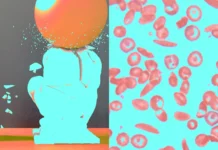Scientists have recently made a revolutionary breakthrough by inventing an artificial leaf that can convert carbon dioxide in the air into renewable fuels that can be used for energy. This artificial leaf, created by researchers at the University of Cambridge, uses the same process of photosynthesis that plants use to turn sunlight into energy. The artificial leaf is powered by solar energy and converts carbon dioxide into renewable fuels that can be used as an energy source. This incredible breakthrough could lead to a new era of renewable energy and could have a huge impact on the environment.
An artificial leaf is a device that mimics the process of photosynthesis in plants to convert sunlight into chemical energy. The goal of artificial leaf technology is to create a sustainable, renewable energy source that can be used to produce solar fuels, such as hydrogen and methanol, from thin air.
The basic principle behind an artificial leaf is to use a semiconductor material, such as silicon, to absorb sunlight and convert it into electrical energy. This electrical energy is then used to split water molecules into hydrogen and oxygen. The hydrogen can then be stored and used as a fuel, while the oxygen is released back into the atmosphere.
Recent developments in artificial leaf technology have led to the creation of more efficient and robust devices. For example, researchers have been able to incorporate catalysts, such as cobalt and iron, into the artificial leaf to improve the efficiency of the water-splitting process. They have also been able to create artificial leaves that can convert carbon dioxide into methanol, a liquid fuel that can be easily stored and transported.

One of the main benefits of artificial leaf technology is that it does not require any external source of energy, such as fossil fuels, to operate. It can be used in remote locations where electricity is not readily available, and it can also be used to produce fuel for transportation, such as cars and airplanes.
Despite the potential benefits of artificial leaf technology, there are still some challenges that need to be overcome before it can be widely adopted. One major challenge is to improve the efficiency of the water-splitting process, as well as to reduce the cost of the materials used to build the artificial leaf.
In conclusion, artificial leaf technology has the potential to revolutionize the way we produce and use renewable energy. By mimicking the process of photosynthesis in plants, it can convert sunlight into chemical energy, which can be used to produce solar fuels such as hydrogen and methanol, making it a sustainable, renewable energy source that can be used to produce solar fuels, such as hydrogen and methanol, from thin air.
Artificial Leaf Converts CO2 To Renewable Fuels:
– An artificial leaf, invented by scientists at the University of Cambridge, can convert carbon dioxide in thin air and sunlight into renewable fuels.
There’s a new technology on the horizon that could have a huge impact on the future of renewable energy. Called an artificial leaf, this ingenious invention uses a catalyst made up of copper, indium and gallium to break down water molecules into oxygen atoms and protons. This process then allows for the creation of energy dense liquid hydrocarbon fuels such as methanol or ethanol.

This technology has the potential to revolutionize both our transportation options and our ability to store solar energy on cloudy days. In addition, it could play a pivotal role in creating sustainable solutions that reduce global dependence on fossil fuels while also providing us with better air quality standards worldwide. Further research is ongoing, but so far the prototype device has shown promising results over several months demonstrating its potential for commercialization in the near future! As this technology becomes increasingly accessible it could play a pivotal role in ushering in a new era of sustainable renewable energy – one that we can all be proud of!
Bottom Line:
The potential of artificial leaves to revolutionize our renewable energy sources is an exciting development for the future. It has the potential to reduce our dependence on fossil fuels, improve air quality standards, and provide us with sustainable solutions for renewable energy storage and transportation. We are all stakeholders in this revolutionary breakthrough, so let us take action now to ensure that we make the most of this incredible opportunity for a better tomorrow!













[…] and gaming, among others. These sensitive systems, also known as artificial or electronic skins, give a flawless and intimate contact with the body allowing, for illustration, […]